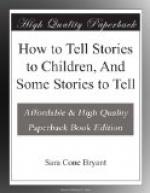Good Mrs Timmin’s History of the Robins, too, is a continuous delight; and from its pompous and high-sounding dialogue a skilful adapter may glean not only one story, but one story with two versions; for the infant of eighteen months can follow the narrative of the joys and troubles, errors and kindnesses of Robin, Dicky, Flopsy and Pecksy; while the child of five or ten or even more will be keenly interested in a fuller account of the birds’ adventures and the development of their several characters and those of their human friends and enemies.
From these two books, from Miss Edgeworth’s wonderful Moral Tales; from Miss Wetherell’s delightful volume Mr Rutherford’s Children; from Jane and Ann Taylor’s Original Poems; from Thomas Day’s Sandford and Merton; from Bunyan’s Pilgrim’s Progress and Lamb’s Tales from Shakespeare, and from many another old friend, stories may be gathered, but the story-teller will find that in almost all cases adaptation is a necessity. The joy of the hunt, however, is a real joy, and with a field which stretches from the myths of Greece to Uncle Remus, from Le Morte d’Arthur to the Jungle Books, there need be no more lack of pleasure for the seeker than for the receiver of the spoil.
* * * * *
The following is a list of valuable sources for the story-teller, all yielding either good original material for adaptation, or stories which need only a slight alteration in the telling.[1]
[Footnote 1: Readers may be interested in A History of Story-telling, by Arthur Ransome. (Jack.)]
THE BIBLE.
MOTHER GOOSE’S MELODY. (Bullen.)
THE STORY HOUR, by Kate Douglas Wiggin. (Gay
& Hancock.)
STORIES FOR KINDERGARTEN. (Ginn.)
ST NICHOLAS MAGAZINE, bound volumes. (Warne.)
LITTLE FOLKS, bound volumes. (Cassell.)
FABLES AND NURSERY TALES, edited by Prof.
Charles Eliot Norton. (Heath.)
STORIES TO TELL THE LITTLEST ONES, by Sara Gone
Bryant. (Harrap.)
MOTHER STORIES, by Maud Lindsay. (Harrap.)
MORE MOTHER STORIES, by Maud Lindsay. (Harrap.)
AESOP’S FABLES.
STORIES TO TELL TO CHILDREN, by Sara Cone Bryant.
(Harrap.)
THE BOOK OF STORIES FOR THE STORY-TELLER, by Fanny
Coe. (Harrap.)
SONGS AND STORIES FOR THE LITTLE ONES, by Gordon
Browne. (Harrap.)
CHARACTER TRAINING (stories with an ethical bearing),
by E.L. Cabot and E.
Eyles. (Harrap.)
STORIES FOR THE STORY HOUR, by Ada M. Marzials.
(Harrap.)
STORIES FOR THE HISTORY HOUR, by Nannie Niemeyer.
(Harrap.)
STORIES FOR THE BIBLE HOUR, by R. Brimley
Johnson. (Harrap.)
NATURE STORIES TO TELL TO CHILDREN, by H.
Waddingham Seers. (Harrap.)
OLD TIME TALES, by Florence Dugdale. (Collins.)
THE MABINOGION. (Dent.)
PERCY’S RELIQUES. (Warne.)




